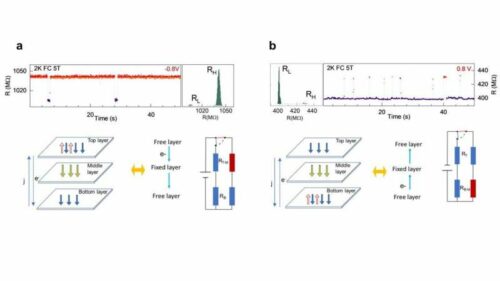Researchers turn electronic noise disruptions into potential spintronic advancements using minuscule vanadium adjustments in tungsten diselenide, a leap towards efficient magnetic switching.

Electronic noise, known as Random Telegraph Noise (RTN), has disrupted electronic systems, leading to signal processing errors. The Center for Integrated Nanostructure Physics researchers, part of the Institute for Basic Science in South Korea, have unveiled a discovery that might utilise these semiconductor fluctuations. This project resulted from joint research efforts with Joo Min-Kyu from Sookmyung Women’s University and KIM Philip at Harvard University.
The researchers have found that by introducing a tiny amount of vanadium into tungsten diselenide (V-WSe2), a vdW-layered semiconductor, they can produce significant RTN signals and magnetic fluctuations. High contact resistance in lateral devices typically hinders the display of natural quantum states, reducing device efficiency. The team developed a vertical magnetic tunnelling junction device to address this, placing several layers of magnetic V-WSe2 material between the top and bottom graphene electrodes. Remarkably, this configuration showcased natural quantum states and generated strong RTN signals with a mere ~0.2% concentration of vanadium doping.
The researchers emphasised that the cornerstone of their work was the generation of significant magnetic resistance fluctuations using vertical magnetic tunnelling junction devices with minimal contact resistance. They detected RTNs that displayed a remarkable amplitude of up to 80% between two clearly defined stable states. In this bistable state, temperature-driven magnetic resistance fluctuations emerge due to the balance between intralayer and interlayer interactions of magnetic domains. The team pinpointed this unique bistable magnetic state by observing discrete Gaussian peaks in the RTN histogram, showcasing distinct noise power spectrum characteristics.
The researchers found that by altering the voltage polarity, they could toggle between the bistable magnetic states and adjust the RTN’s cut-off frequency. This opens avenues for utilising 1/f^2 noise spectroscopy in magnetic semiconductors and introduces magnetic switching in spintronics. They believe this marks an effort to discern the bistable magnetic state through substantial resistance fluctuations in magnetic semiconductors, presenting a magnetic switching method using 1/f^2 noises through straightforward voltage polarity adjustments in spintronics.






